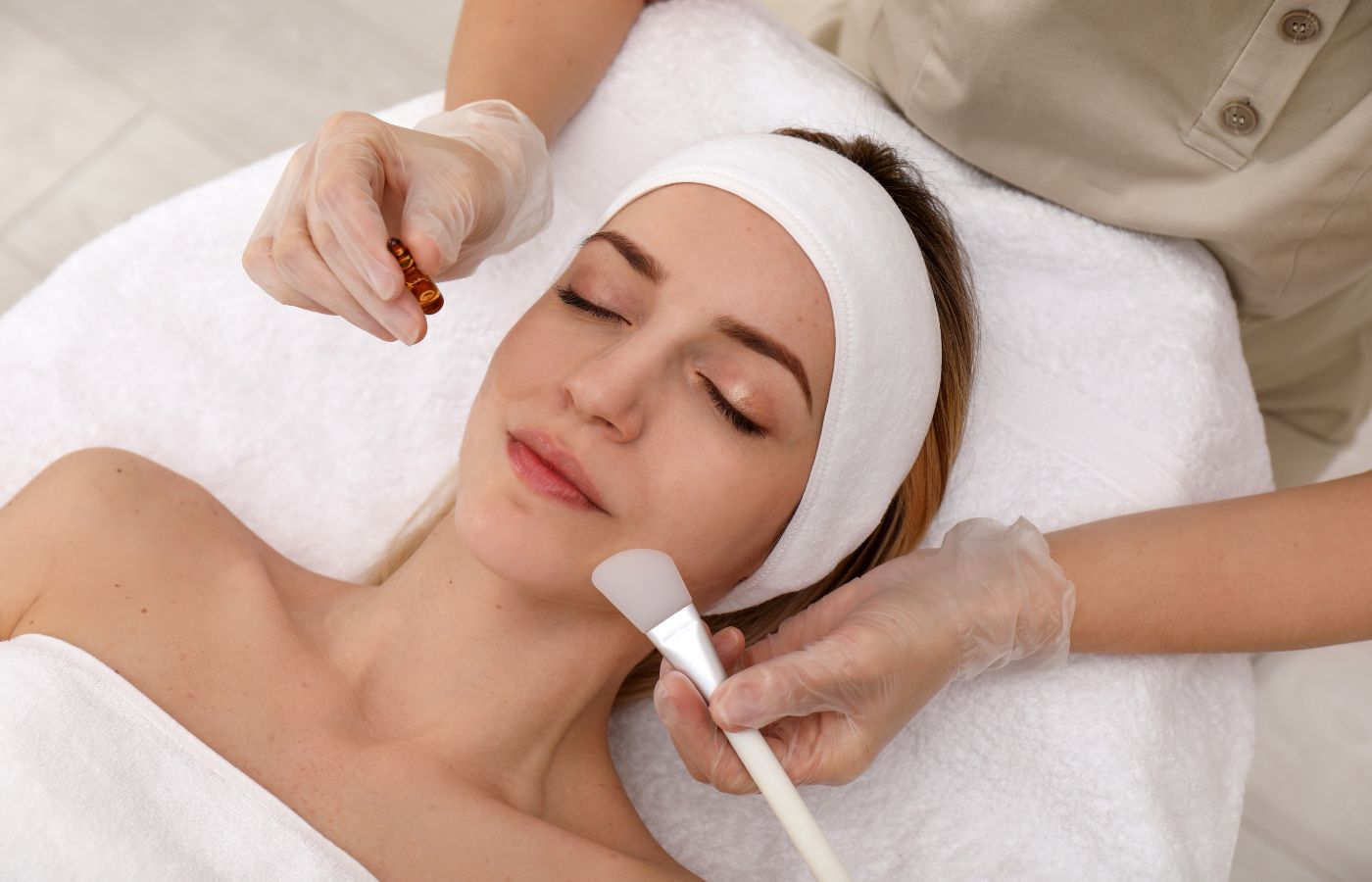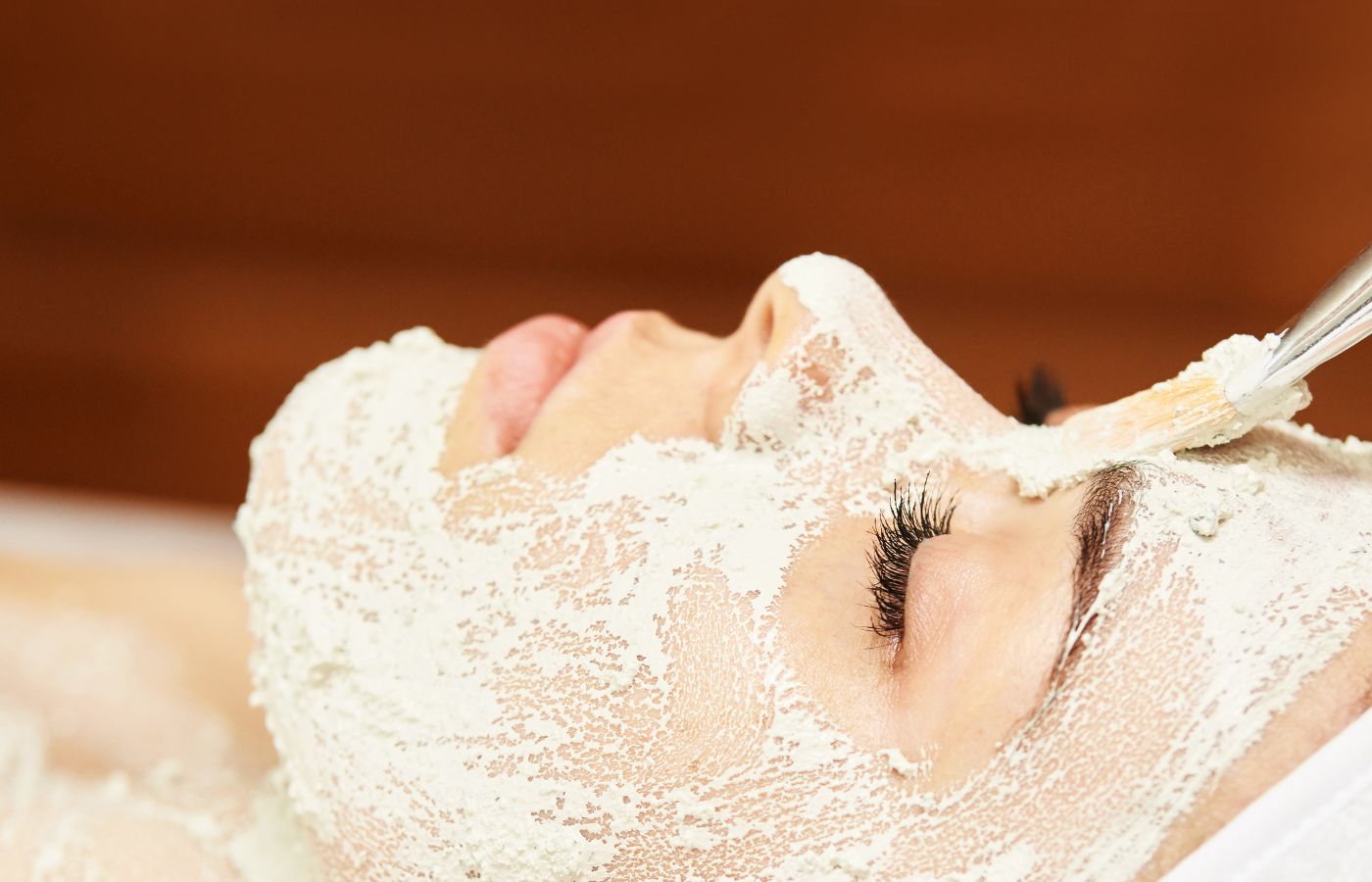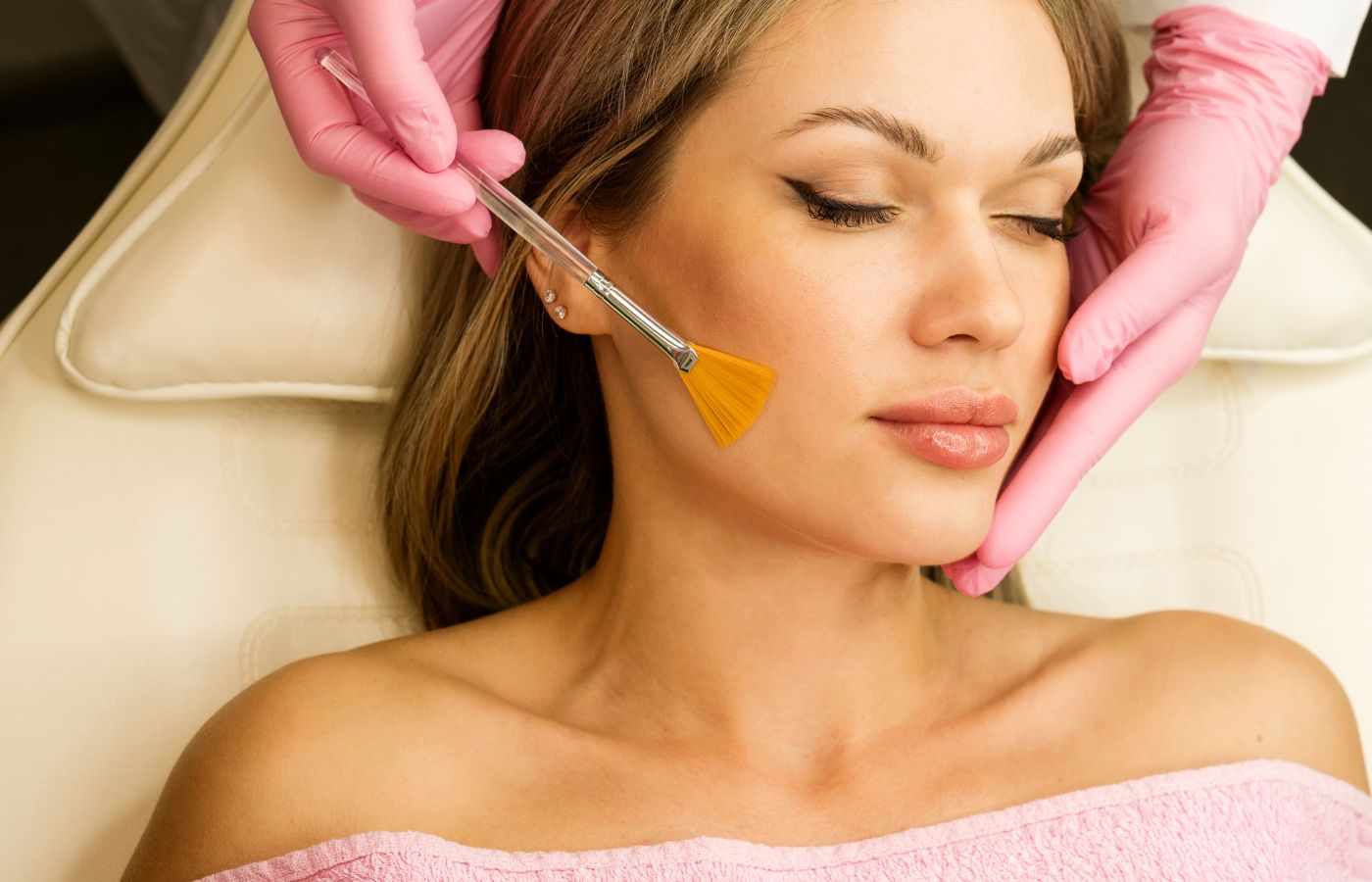Chemical Peels
Are you looking to rejuvenate your skin and address various skin concerns? Chemical peels might be the answer you’ve been searching for. At Bay Street Salon and Spa, we offer professional chemical peel treatments to help you achieve a smoother, more youthful complexion. Our skilled esthetician, specializes in tailoring chemical peels to your unique needs. Learn more about the transformative power of chemical peels and the benefits they offer.

What is a Chemical Peel?
Key Benefits of Chemical Peels
Reduce Fine Lines and Wrinkles
Correct Sun Damage
Prolonged exposure to harmful UV rays can lead to dark spots, uneven pigmentation, and a rough skin texture. Chemical peels effectively fade sunspots, even out skin tone, and restore radiance.
Combat Acne and Acne Scars
Enhance Skin Tone and Texture
Chemical peels even out rough or dull skin, minimize the appearance of pores, and enhance overall skin clarity.
At Bay Street Salon and Spa, Dr. Julie Lockman offers comprehensive skin assessments and expert chemical peel treatments. With her extensive medical expertise and commitment to positive aging, you can trust us to help you achieve dramatic improvements in your skin. Experience the multitude of benefits that chemical peels can bring and reveal a more youthful, radiant you.

Types of Chemical Peels
Chemical peels come in various types, each catering to specific skin needs and concerns. At Bay Street Salon and Spa , we offer a range of chemical peels designed to address various skin issues and provide customized solutions:
Lactic Acid Peels
Glycolic Acid Peels
Trichloroacetic Acid (TCA) Peels
Recommended for severe skin concerns. These deep peels target deep scars, severe wrinkles, and uneven pigmentation.
Our experienced dermatologic surgeon, Dr. Julie Lockman, will analyze your skin type and specific concerns to determine the most suitable type of peel for you. Whether you require a superficial peel for a quick refresh or a deeper peel for more dramatic improvement, we have the right chemical peel for your needs.
Superficial Peels
Superficial peels are a popular choice to improve the appearance of your skin. They target skin issues that affect the top layer, or epidermis, of the skin. If you have rough skin or an uneven skin tone, a superficial peel may be just what you need.
One of the significant advantages of superficial peels is their lower risk of side effects compared to deeper peels. They only target the outermost layer of the skin, resulting in less disruption to the underlying tissue. As a result, recovery time is quicker, allowing you to return to your regular routine sooner.
During a superficial peel, a chemical solution containing mild acids like lactic acid or glycolic acid is applied to the skin. This solution gently exfoliates and removes the outer layer of dead skin cells, revealing a smoother and more radiant complexion underneath.
Keep in mind that while superficial peels can improve your skin’s appearance, they may not be suitable for everyone or all skin types. Consult with Dr. Julie Lockman or one of our experienced professionals to determine if this cosmetic procedure is right for you.
In summary, superficial peels offer a convenient and effective option for addressing skin issues that primarily affect the top layer. With their lower risk of side effects and quicker recovery time, they can help you achieve a smoother, more even skin tone.
Medium Peels
Medium peels, also known as medium-depth peels, are effective cosmetic treatments to improve fine wrinkles, sun-damaged skin, minor hyperpigmentation, and minor acne scars. These peels penetrate deeper into the skin compared to superficial peels, targeting the middle layer known as the dermis.
During a medium peel, a chemical solution containing ingredients like glycolic acid or trichloroacetic acid is applied to the skin. This solution exfoliates and removes damaged skin cells, stimulating the production of new collagen and elastin fibers. As a result, the skin becomes smoother, firmer, and more even-toned.
While medium peels offer significant benefits, it’s important to be aware of potential side effects. Some individuals may experience a stinging or burning sensation during the application of the chemical solution. Temporary blue coloring of the skin may also occur in rare cases but will fade over time.
After a medium peel, it is crucial to follow proper precautions and aftercare measures. This may include using a prescribed solution or ointment, avoiding sun exposure, and taking antiviral medication if prone to cold sores. It’s essential to protect the newly treated skin from the sun until it has fully healed, which typically takes around 7-14 days.
If you are considering a medium peel, consult with Dr. Julie Lockman at Bay Street Salon and Spa to determine if it is suitable for your skin concerns. Dr. Lockman offers comprehensive skin assessments and expert care to help you achieve your desired results.
Deep Peels
Deep peels are designed to address moderate to severe skin issues such as sun damage, wrinkles, and hyperpigmentation. This procedure involves the application of a chemical solution, typically phenol, to the skin using a cotton-tipped applicator.
Deep peels penetrate into the middle layer of the skin, also known as the dermis, providing more dramatic improvement compared to superficial or medium peels. However, it’s important to note that deep peels are more invasive and have a longer recovery process.
Following a deep peel, patients may experience significant swelling, redness, and discomfort. It is crucial to follow the aftercare instructions provided by your dermatologic surgeon, which may include applying petroleum jelly to keep the skin moisturized and protected from exposure.
Due to the deeper nature of these peels, it is recommended to avoid sun exposure until the skin has fully healed. Complete recovery may take several weeks, during which time the skin may appear red and flaky.
Deep peels are typically recommended for individuals with more severe skin conditions. It’s important to consult with a qualified professional, such as Dr. Julie Lockman at Bay Street Salon and Spa, to determine if a deep peel is the right cosmetic treatment for you. With her expertise and comprehensive skin assessments, Dr. Lockman can guide you towards achieving your desired results.

Different Acids Used in Chemical Peels
Chemical peels are a popular cosmetic treatment that improves the skin’s appearance by applying a chemical solution to exfoliate and remove damaged skin cells. Different types of acids are used in chemical peels to target specific skin concerns and achieve desired results. Here are some of the common acids used in chemical peels:
Lactic Acid
Glycolic Acid
Trichloroacetic Acid (TCA)
Salicylic Acid
Phenol or Carbolic Acid
Phenol or carbolic acid may be used in deep peels, providing dramatic improvements for severe wrinkles, deep scars, and significant sun damage.
When considering a chemical peel, it’s essential to consult with a qualified dermatologic surgeon like Dr. Julie Lockman at Bay Street Salon and Spa , Embrun. They can assess your skin type and concerns to recommend the most suitable type of peel for you. Always follow post-treatment instructions to ensure proper healing and optimal results.
Lactic Acid
Lactic acid is a highly effective and commonly used ingredient in chemical peels. As an alpha hydroxy acid (AHA), lactic acid works wonders in improving the appearance and texture of the skin. Here’s why lactic acid peels are beneficial:
Gentle Exfoliation
Stimulates Collagen Production
Targeting Age Spots and Pigmentation
Lactic acid is effective in targeting age spots and uneven pigmentation. It inhibits melanin production, which helps fade dark spots and even out skin tone.
Lactic acid is used in various products and treatments, from at-home peels to professional treatments. These may include lactic acid-based peels, serums, creams, and masks. If you’re looking to improve rough skin, age spots, or uneven pigmentation, incorporating lactic acid-based products into your skincare routine or consulting with a dermatologic surgeon for a professional lactic acid peel can provide significant benefits.
Glycolic Acid
The Powerhouse Alpha-Hydroxy Acid in Chemical Peels
Glycolic acid, an alpha-hydroxy acid (AHA), is a potent ingredient commonly used in chemical peels. It is known for its incredible exfoliating properties and its ability to rejuvenate the skin. Here’s why glycolic acid is a skincare powerhouse:
Acne Scar Reduction
Stretch Mark Improvement
Glycolic acid can also address stretch marks by removing the top layer of dead skin cells, promoting a more uniform texture and reducing the visibility of stretch marks.
Hyperpigmentation Control
Whether caused by sun damage or hormonal fluctuations, glycolic acid is effective in treating hyperpigmentation. It inhibits the production of melanin, the pigment responsible for dark spots and uneven skin tone. Consistent use of glycolic acid-based chemical peels can lead to a more radiant complexion with reduced hyperpigmentation.
Glycolic acid is just one example of an alpha-hydroxy acid commonly used in chemical peels. Other AHAs, such as lactic acid and citric acid, offer similar benefits and are frequently utilized by skincare professionals to address a range of skin concerns.
Incorporating glycolic acid-based chemical peels into your skincare routine can bring remarkable improvements to your skin, effectively targeting acne scars, stretch marks, and hyperpigmentation. Reach out to Dr. Julie Lockman at Bay Street Salon and Spa , Embrun, for a comprehensive skin assessment and professional treatment options using glycolic acid and other skincare wonders.
Salicylic Acid
In the realm of chemical peels, salicylic acid emerges as a powerful ingredient with a range of benefits and applications. As a beta-hydroxy acid (BHA), salicylic acid offers unique advantages, especially for those with acne-prone skin and enlarged pores. Here’s why salicylic acid is a skincare hero:
Deep Pore Penetration
Minimizes Enlarged Pores
Rejuvenates the Epidermis
Beyond its efficacy in treating acne and pore issues, salicylic acid is also renowned for its rejuvenating effects on the epidermis. It promotes gentle exfoliation, shedding dead skin cells and revealing fresher and more youthful-looking skin.
Overall, salicylic acid’s versatility and compatibility with acne-prone skin and enlarged pores make it a crucial component in chemical peels. Whether you’re struggling with acne, pore visibility, or simply seeking skin rejuvenation, salicylic acid can provide an effective solution.
If you’re considering a chemical peel with salicylic acid, consult with Dr. Julie Lockman at Bay Street Salon and Spa, Embrun. With her extensive medical expertise and dedication to comprehensive skin assessments, she can guide you towards achieving your desired skincare goals.
Trichloroacetic (TCA) Acid
Trichloroacetic acid (TCA) is a commonly used chemical solution in chemical peels, renowned for its versatile properties and effectiveness in addressing various skin concerns. TCA acid works
by exfoliating the outer layer of the skin, facilitating the rejuvenation process. Here’s why TCA acid peels are beneficial:
Acne Scar Reduction
Sun Damage Correction
TCA acid aids in removing sun-damaged areas such as age spots and uneven pigmentation. It removes the damaged outer layer of the skin, revealing smoother and more even-toned skin underneath.
Wrinkle Improvement
TCA acid is also effective in reducing the appearance of wrinkles. It stimulates collagen production in the middle layer of the skin, gradually improving fine lines and wrinkles. However, it’s important to note that TCA acid is generally not recommended for deep wrinkles or severe skin sagging, as deeper peels or surgical procedures may be more suitable in such cases.
While TCA acid offers remarkable benefits, it’s essential to be aware of its potential side effects and precautions. After a TCA peel, patients may experience redness, swelling, and a stinging sensation. It is crucial to follow proper aftercare instructions, including avoiding excessive sun exposure and using recommended skincare products. Additionally, individuals with certain skin conditions, like cold sores or black skin, may require additional precautions before undergoing TCA acid peels.
Overall, when performed by a trained professional, TCA acid in chemical peels can provide significant improvements in skin texture, acne scars, sun damage, and mild to moderate wrinkles. Consult with a dermatologic surgeon like Dr. Julie Lockman at Bay Street Salon and Spa , Embrun, to determine if TCA acid peels are the right solution for your skin concerns.

Solutions Used in Chemical Peels
Chemical peels are effective cosmetic treatments that involve the application of chemical solutions to the skin. These solutions play a crucial role in improving various skin conditions and rejuvenating the skin’s appearance. Different types of chemical solutions are commonly used, including glycolic acid, trichloroacetic acid (TCA), salicylic acid, lactic acid, and carbolic acid.
Glycolic Acid
Glycolic acid is a popular choice for superficial peels due to its ability to gently exfoliate the outer layer of the skin. It is particularly effective in improving skin texture, minimizing fine lines, and reducing sun damage.
Trichloroacetic Acid (TCA)
TCA acid is often used in medium peels, as it penetrates deeper into the skin to address issues like uneven pigmentation and age spots.
Salicylic Acid
Salicylic acid is known for its ability to penetrate the pores and exfoliate deep within the skin. It is commonly used for acne-prone and oily skin types, helping to unclog pores and reduce acne breakouts.
Lactic Acid
Phenol or Carbolic Acid
Phenol or carbolic acid may be used in deep peels, providing dramatic improvements for severe wrinkles, deep scars, and significant sun damage.
The choice of solution used in a chemical peel depends on the desired outcome and an individual’s skin type. A comprehensive skin assessment performed by a qualified professional, such as Dr. Julie Lockman at Bay Street Salon and Spa , Embrun, can help determine the most suitable solution for each patient’s needs.
Overall, the solutions used in chemical peels offer a range of benefits, from exfoliating the outer layers of the skin to addressing specific skin concerns. With the expertise of a skilled physician injector like Dr. Lockman, patients can confidently undergo chemical peels to achieve healthier, more radiant skin.
Factors to Consider Before Getting a Chemical Peel
Before undergoing a chemical peel, there are several important factors to consider to ensure the best possible results and minimize any potential risks. The expertise of a qualified professional, such as Dr. Julie Lockman at Bay Street Salon and Spa in Embrun, is crucial in guiding individuals through this cosmetic procedure. Here are some key factors to consider:
Skin Type and Family History
Your skin type and family history play a significant role in the success of a chemical peel. Different skin types react differently to chemical peels, and certain skin conditions may be hereditary. Understanding your skin type and family history helps customize the treatment and minimize risks.
Age Spots and Sun Damage
Age spots and sun damage can impact your skin’s appearance, causing uneven pigmentation and texture issues. Chemical peels are effective in addressing these concerns by exfoliating damaged skin cells and promoting a more youthful complexion. Consult with a dermatologist or aesthetician to determine the best approach.
Desired Outcome
Recovery Time
Consider the recovery time associated with the type of chemical peel you choose. Superficial peels generally have a shorter recovery period compared to medium or deep peels. Plan accordingly and follow post-treatment instructions for optimal healing.
Skin Conditions
If you have any existing skin conditions, such as eczema or psoriasis, inform your healthcare provider. They can assess whether a chemical peel is suitable for your skin and recommend any necessary precautions.
Skincare Routine
Evaluate your current skincare routine and disclose any products or treatments you’re using to the professional performing the chemical peel. They can provide guidance on adjusting your routine before and after the procedure.
Expectations and Questions
Address any questions or concerns you may have about the procedure. Clear communication with your healthcare provider ensures that you have realistic expectations and are well-informed about the process.
Before scheduling a chemical peel, consult with a qualified dermatologic surgeon like Dr. Julie Lockman at Bay Street Salon and Spa in Embrun. A comprehensive skin assessment and discussion of these factors will help you make an informed decision about whether a chemical peel is the right choice for your skin concerns. Dr. Lockman’s expertise and commitment to personalized care will ensure a positive and successful experience.
Bay Street Salon and Spa is dedicated to helping you achieve the best results and reveal your most radiant self. Dr. Julie Lockman, our experienced dermatologic surgeon, is here to provide comprehensive skin assessments and expert care. Contact us today to begin your journey to healthier, more beautiful skin.
Ready for a Change?
It will only take a few minutes to fill in the form. We will contact you shortly and schedule a consult tailor-made for you.
Reviews from our Clients



